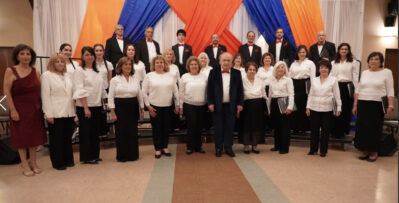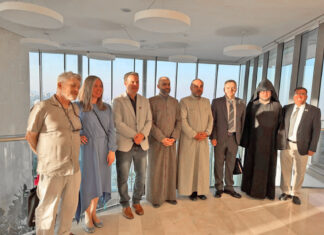By Florence Avakian
NEW YORK — An awe-inspiring but gravely worrying lecture on the preservation of historic Armenian churches in danger of collapse, was presented by leading Armenian art historian Dr. Christina Maranci recently. It was sponsored by the Zohrab Information Center of the Diocese of the Armenian Church of America. The seventh-century religious icons in question, Mren, Zvartnots and Pighni were explored in the context of their unique designs, their historical time period, their vibrant culture, and their current significance.
Maranci who has since returned to Turkey to investigate the current condition of Mren Cathedral, is the Arthur H. Dadian and Ara T. Oztemel Professor of Armenian Art at Tufts University. During the lecture, she also introduced her latest book, Vigilant Powers: Three Churches of Early Medieval Armenia.
Focusing her talk exclusively on Mren, which is in an active seismic region, she warned that it “could fall to the ground any day.” It is one of more than 100 churches thought to date from seventh-century Armenia and Georgia, the “Golden Age” of building, which was “more robust than anyplace in the contemporary Mediterranean area. These monuments were produced in the South Caucasus — Turkey, Iran, Georgia, Armenia and Azerbaijan, during a time of escalating warfare between Byzantine and Persian superpowers, and saw the shakedown of Byzantine power, the collapse of the Sasanian dynasty, and the establishment of the Umayyad caliphate, all of which brought on the beginning of the Middle Ages.
Completed circa 639, and remarkable for its size — 32 meters in length — Mren is the second-largest domed basilica preserved from the seventh-century Caucasus, and “exceeds in length the far more celebrated and nearby 11th-century Cathedral of Ani,” pointed out the Armenian scholar. It is also very rich in sculpture.”
Situated in the Kars region, it is today inside a closed and militarized border zone, just a few kilometers from Armenia. This all complicated Maranci’s application for a research visa which in 2010 was denied. She related that Mren passed from Ottoman to Russian to Armenian, and finally in 1920 to Turkish control under the terms of the Treaty of Alexandropol. Also of great interest to her, was evidence of a palace at the site, which from the 5th to 13th centuries, had been a large settlement, with the possibility of roads, or even canals for irrigating the vineyards, for which Mren was famous.







